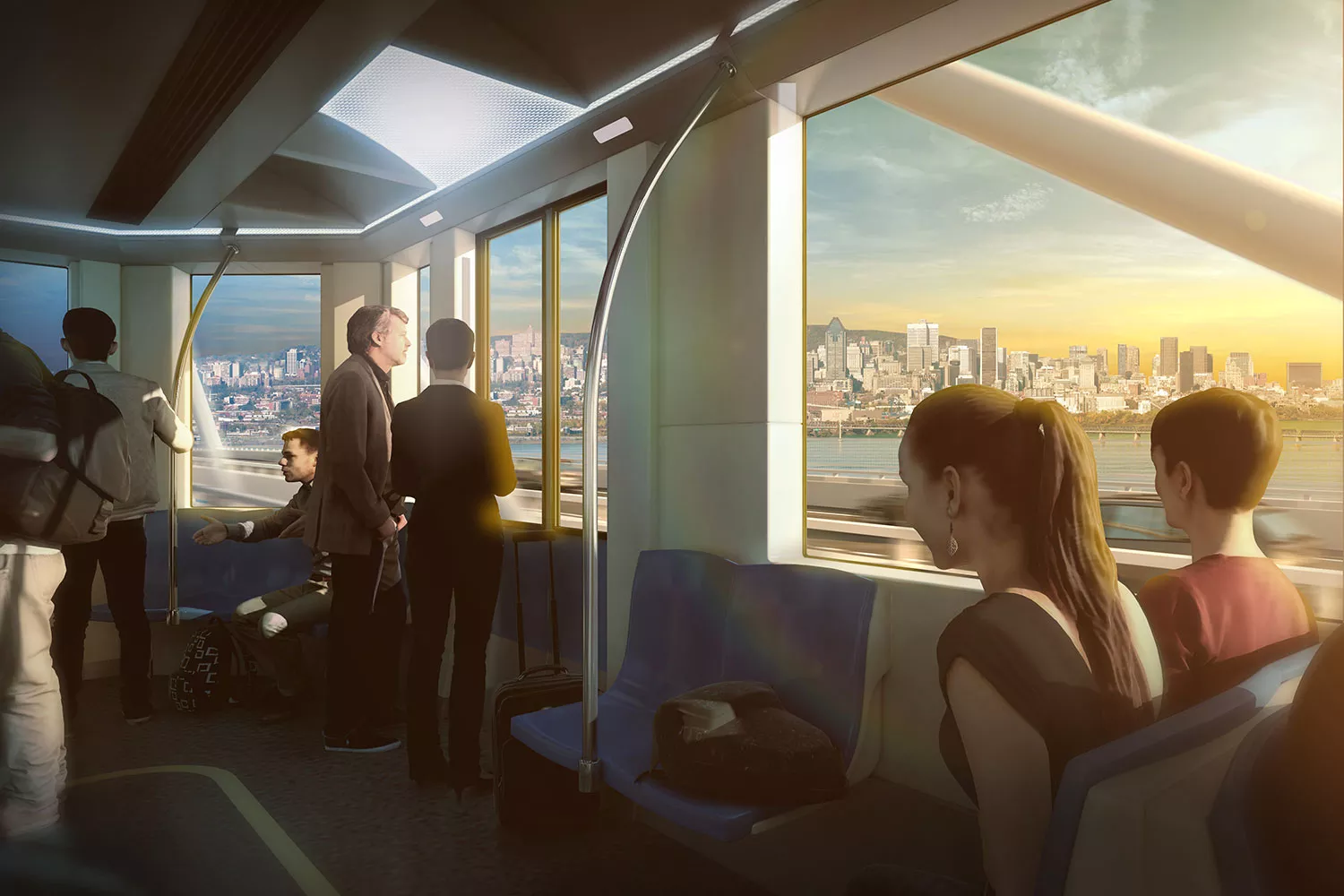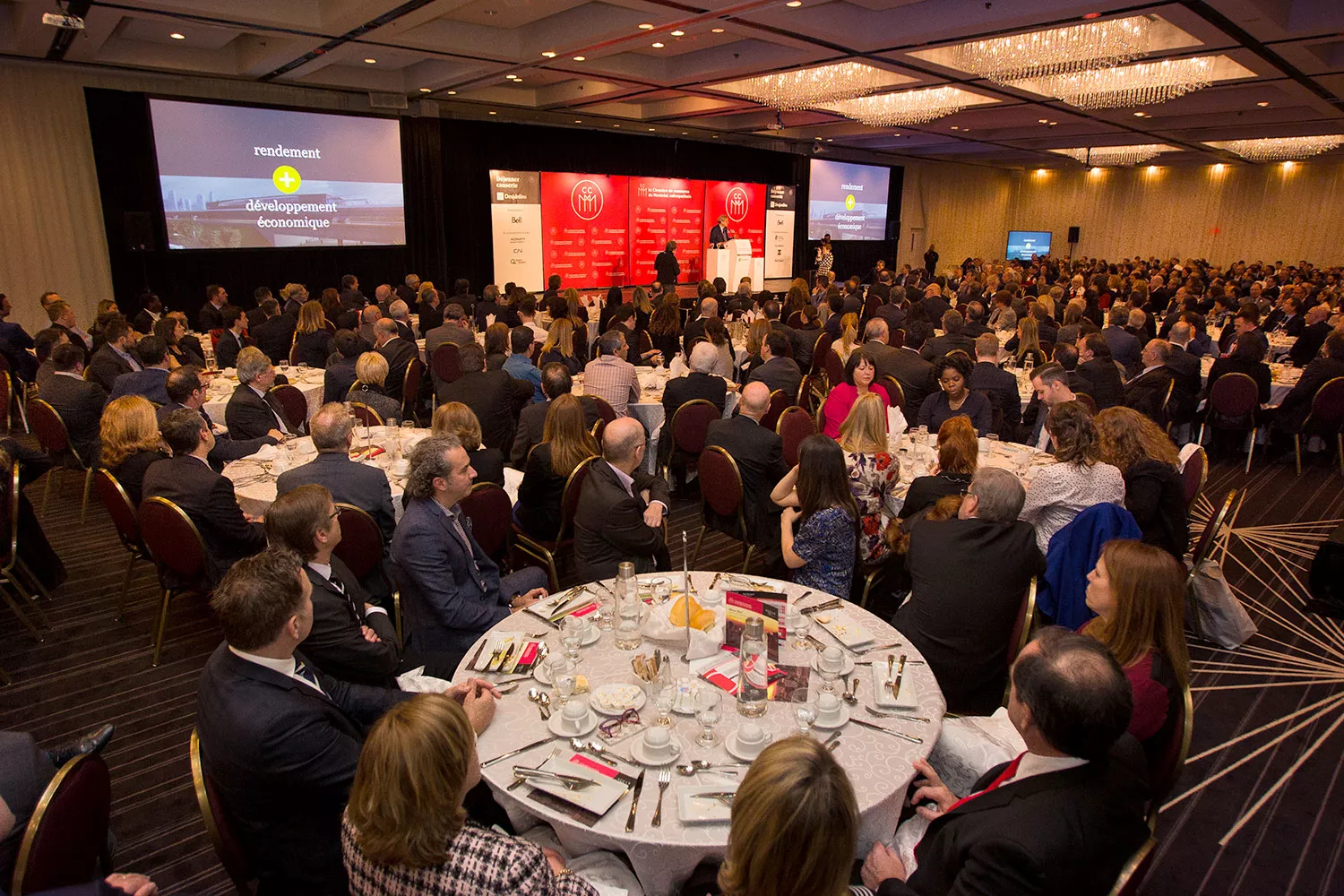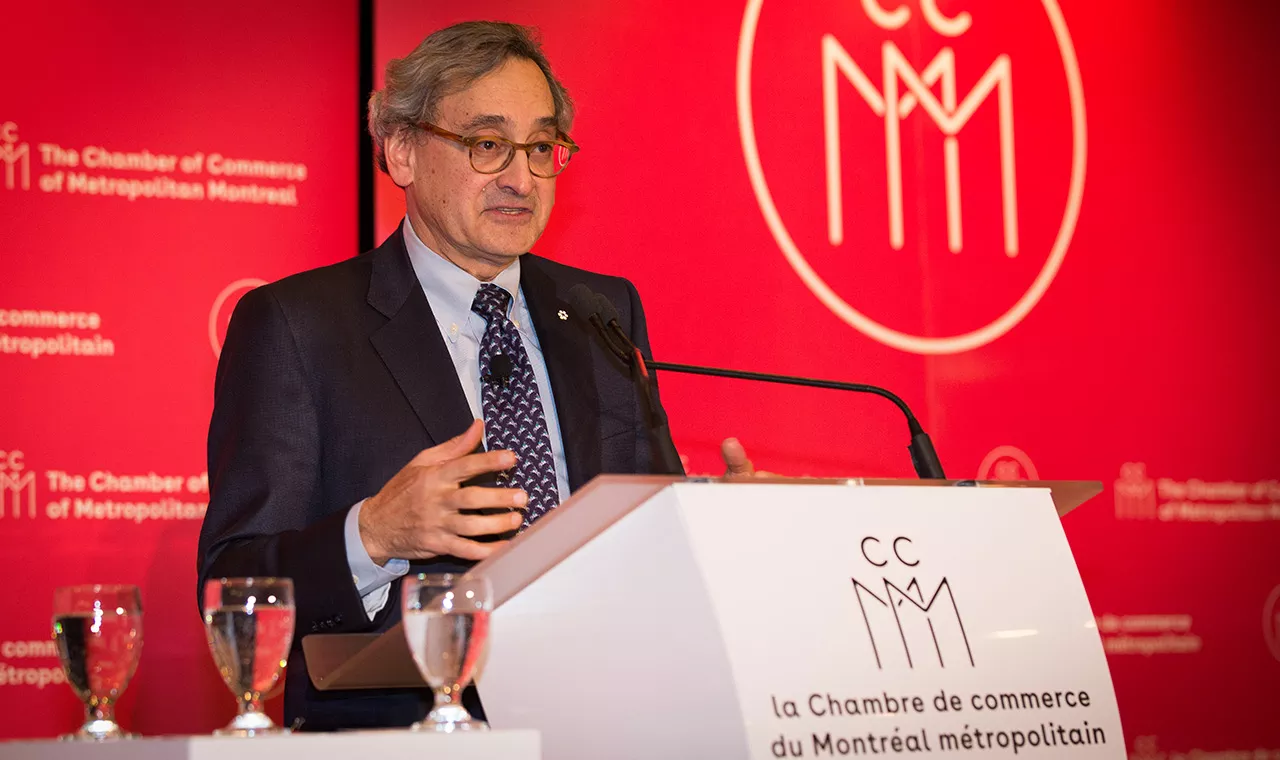Moving Montréal forward
Check against delivery.
Trains every three minutes. In the future, every 90 seconds.
Crossing the Champlain Bridge at close to 100 km/hr.
Brossard to downtown in 16 minutes. Weekdays and weekends.
Express service from downtown to the airport in less than 20 minutes. Rain or shine.
A 67-kilometre network. Twenty hours a day, seven days a week.
Wi-Fi in every train car. Universal access to stations, including for wheelchairs.
That’s the Réseau Électrique Métropolitain.
A network that will transform Montréal.
Why would an institutional investor like la Caisse take such a detailed interest in public transit?
Why am I not talking about currency movements or portfolio weightings? Or about our geopolitical risk analysis of the Trump Administration, which we follow every day?
Modern, fast and sustainable transportation that will make the Montréal area as dynamic as its entrepreneurs.
Because the REM is at the heart of who we are as an institution.
An institution that invests to generate returns, and contributes to Québec’s economic development. Two missions that go hand in hand. And which the REM embodies more than any other investment project.
A project that will generate returns for all Québecers. Think about it: every time you use the REM, you will be solidifying your retirement.
The REM lines up with everything we’ve done for the past 50 years. Our mission hasn’t changed, but the way we go about executing it is flexible. It evolves with the times.
When it was created, la Caisse contributed to the Québec Government’s financial autonomy by investing in its bonds. It fostered the emergence of a francophone financial class. On these foundations, la Caisse helped to build Québec’s economic champions during the 80s.
La Caisse continues to evolve to this day. Always as a builder. With low interest rates and volatile markets, we want to invest in infrastructure. In the development of bold and dynamic cities. Because energized cities attract the brightest minds. The most ambitious projects. And drive the economic growth of their countries.
Montréal is one of these vibrant cities. It’s clear in the latest job figures. More than 70,000 net new jobs created in Greater Montréal last year. That’s more than all other Canadian cities combined.
Behind those numbers are success stories of the new economy.
Rodeo FX, Moment Factory, Felix & Paul. Stars in the special effects, events and virtual reality industries.
Yoshua Bengio is recognized around the world for research that pushes the boundaries of artificial intelligence.
There’s Hopper. Lightspeed. Breather.
Montréal is on the move. Unfortunately, our infrastructure isn’t keeping up. Worse, it’s holding us back. It limits our economic potential and our competitiveness.
That’s why we urgently need to build efficient public transit infrastructure. Modern, fast and sustainable transportation that will make the Montréal area as dynamic as its entrepreneurs.
Examples?
- With the REM, it will take only three minutes for researchers from Université de Montréal and McGill to meet.
- On the Deux-Montagnes line, trains will increase nearly four-fold during rush hour. One every five minutes.
- The West Island will finally have regular and reliable train service.
Through our investments, we’ve seen first-hand the vitality of cities with efficient public transit systems. Heathrow Express, in London. And of course the Canada Line in Vancouver.
Every time you use the REM, you will be solidifying your retirement.
La Caisse has been investing globally in infrastructure for more than 15 years. Fifteen years during which we built a nearly $15 billion portfolio, including investments in Eurostar and Keolis, a multinational moving 3 billion people a year in 16 countries.
We want to put this expertise, acquired in Europe, the United States and Australia, to work here in Québec.
We want to focus it on the REM.
To energize Montréal. To contribute to Québec’s economy. To further la Caisse’s mission as a builder, which benefits all Québecers.
***
Of course our REM project has inspired many discussions since it was launched. That’s perfectly normal.
You don’t build a nearly $6 billion public transit network everyday. It’s a major project. Our responsibility matches its scale. The questions we’re being asked are legitimate.
Some of the most important ones relate to the REM’s costs. This is a relevant issue. Montréalers have had bad surprises in the past.
We said recently that the cost of building and operating the REM would be between 2% and 4% higher than the cost of current networks. In other words, for a comparable budget, Greater Montréal gets the equivalent of a second Metro system.

All that is true. And it’s very important.
But it’s not the whole story.
Why?
Because comparing the REM with the current situation is like comparing apples to oranges.
Current transit authority budgets don’t include all the costs of public transportation. They include operating costs but only a fraction of capital costs. A major part – in fact the majority – of the costs of construction, trains, buses, etc. doesn’t appear in these budgets. These expenses are on the governments’ books.
My point is not to criticize this model, but if we really want to compare apples to apples, we need to include all costs. That means 100% of the capital costs and 100% of the operating costs. That’s what we’re doing with the REM.
And when you compare apples to apples, the result is very clear: the REM is much less expensive. In other words, you’ll get more bang for your buck.
***
For a comparable budget, Greater Montréal gets the equivalent of a second Metro system.
If I speak with such conviction, it’s because I think the REM represents a revolution in the way we do things.
Our low costs stem from the way we work. A continuous engineering approach, that stands out from traditional ways of doing things in Québec. A fast and efficient approach that has proven its worth elsewhere in the world.
In France, a high-speed train linking Tours and Bordeaux will begin service this summer. It’s a 340-kilometer project, passing through almost 120 communities. And it will have been built in five years, on budget.
There are other examples, including in Malaysia and Australia. Major train projects, completed on time and on budget.
These projects are successes. If France, Australia and Malaysia can innovate, why can’t we? Why not improve on models that have showed their limitations?
Québecers are not condemned to delays and cost overruns.
That’s exactly why we chose a new way of doing things. To improve our processes. To make them more efficient, more flexible.
Continuous engineering is an open approach. It’s based on collaboration. It leverages the best ideas to improve a project – no matter where they come from. From cities or businesses. From governments or the public.
We determine the main parameters. But we give contractors the freedom to propose the most innovative solutions and technologies.
It’s an approach that enables us to work more effectively. With utmost rigour. By continuously improving the REM.
I recently saw a nice phrase to describe this approach: a “call for solutions.”
Continuous engineering is based on openness. Confidence. It’s an approach that considers our challenges to be far from insurmountable. I believe that when Québec rolls up its sleeves and summons its ingenuity, nothing can stop us.
***
When you compare apples to apples, the result is very clear: the REM is much less expensive.
At the risk of repeating myself, listening is key. Since the REM was announced, we participated in hundreds of meetings. With city and government officials. With municipal and transit authority representatives. With various groups and members of the public.
We met with more than 3,000 people during 12 open-house events. To better understand their needs. To answer questions.
Those meetings led to several concrete improvements:
- We added three downtown stations because connections to the metro count. They’ll make the whole system more fluid and easier to use;
- We modified the route to protect heritage buildings in Griffintown;
- We modified the route to protect ecologically important wetlands;
- And we announced partnerships with Téo Taxi, Netlift, Bixi, Car2go and VéloQuébec to improve access and to provide more choice.
These discussions and consultations will continue until the project is completed. With experts, municipalities and, of course, with citizens, whose needs, preoccupations and suggestions we’ll continue to solicit and take into account.
Discussions with the ARTM are ongoing, looking for the best way to integrate the REM into existing transit systems.

We are also working with the Ministère de l’Environnement to follow up on the BAPE’s recommendations.
***
We are obviously convinced that the REM is an exceptionally valuable project for the Montréal region, for la Caisse, and for all Québecers.
But can it be improved?
Absolutely.
And that’s what we’ll do.
Take the issue of agricultural lands.
We take seriously the risk of urban sprawl in the Montréal area. But we also believe there are ways to protect agricultural lands while maintaining the South Shore terminal at its optimal location.
That’s why we’re making the following commitment: there will be more agricultural lands when the REM begins operations than there are today – not less.
From groundbreaking to its 30th anniversary, the project will thus contribute to reducing GHG emissions.
Building the REM is not just about resolving challenges. It’s also an incredible opportunity to build a transportation network that is in sync with Montréalers and their values.
As an electric network, the REM is inherently green. During its first year of operation, it will cut GHG emissions by 35,000 tonnes in the Montréal region.
Can we improve on this performance?
Absolutely.
And that’s what we’ll do.
Today we are committing to compensate GHG emissions from the REM’s construction. From groundbreaking to its 30th anniversary, the project will thus contribute to reducing GHG emissions.
To achieve this, we will plant 250,000 trees in the Montréal area. In collaboration with Earth Day and the 375,000 trees program.
250,000 trees represent 208 hectares. That’s bigger than Mont Royal Park.
These trees will make our city even greener. They will give the REM a human dimension. They will blend into neighbourhoods and improve local communities.
Can we improve these neighbourhoods even more?
Absolutely.
And that’s what we’ll do.
Because a neighbourhood isn’t just infrastructure and green spaces. A train network isn’t just concrete and steel. It’s also a cultural space. A living environment.
Because the REM is an innovative project, we want the creativity and imagination of Montréalers to be at the heart of the new network. We want Montréal residents and commuters to give the REM personality. So that it becomes a living extension of who we are. Of what we love about Montréal.
That’s why we’re going to have open contests to integrate art, culture and the environment into the REM, to be launched during the construction phase. We want new ideas, inspired by the best examples throughout the world.
- Why not temporary installations or murals, like in Miami’s Wynwood neighbourhood?
- Why not a park like the High Line in New York? Or vertical gardens?
- Why not concepts like the Luchtsingel project in Rotterdam?
These are just a few ideas. We want more. And we want them to come from the public. From the architects, artists and creators who put Montréal on the map.
We have a unique opportunity to build infrastructure that will be part of Montréal’s signature. That will make it attractive, modern, efficient and inspiring.
We have a unique opportunity to build infrastructure that will be part of Montréal’s signature. That will make it attractive, modern, efficient and inspiring.
The REM will be a window for Montréal’s genius. For its talent. For its environment. For its creativity. For its pride.
For our ability to think differently. To invent new ways of doing things. To question the status quo. Like our businesses and researchers do. And like the next generation certainly will.
Can la Caisse further this movement and help to make Montréal a model city for the 21st century?
Absolutely.
And that’s what we’ll do.


